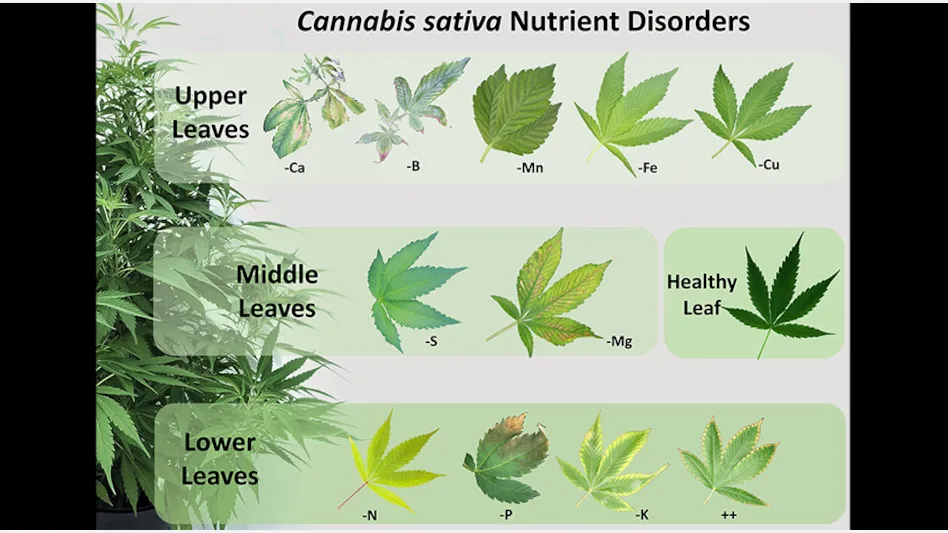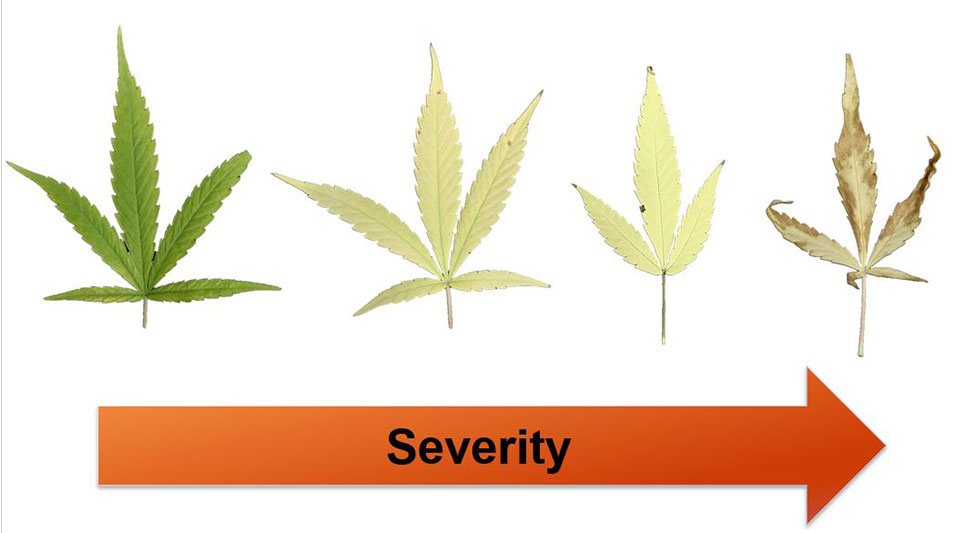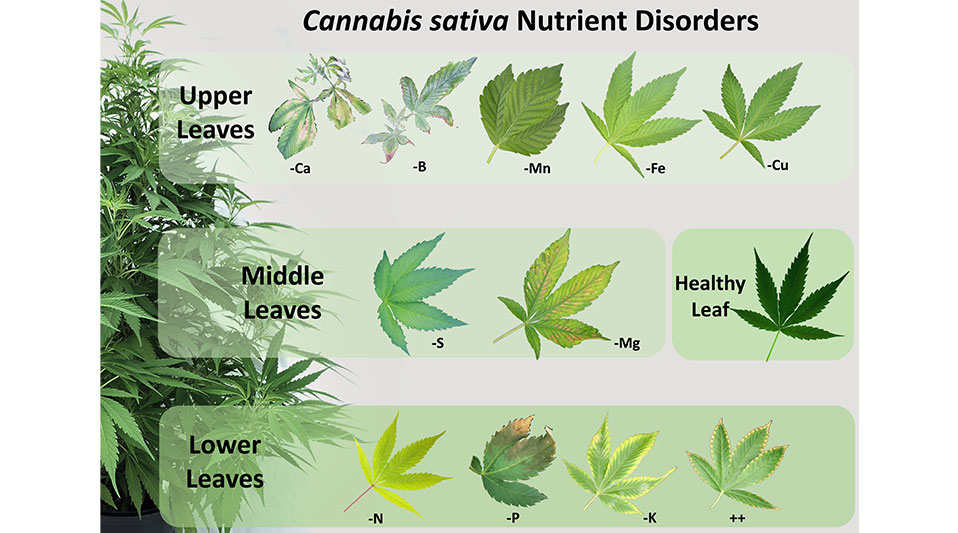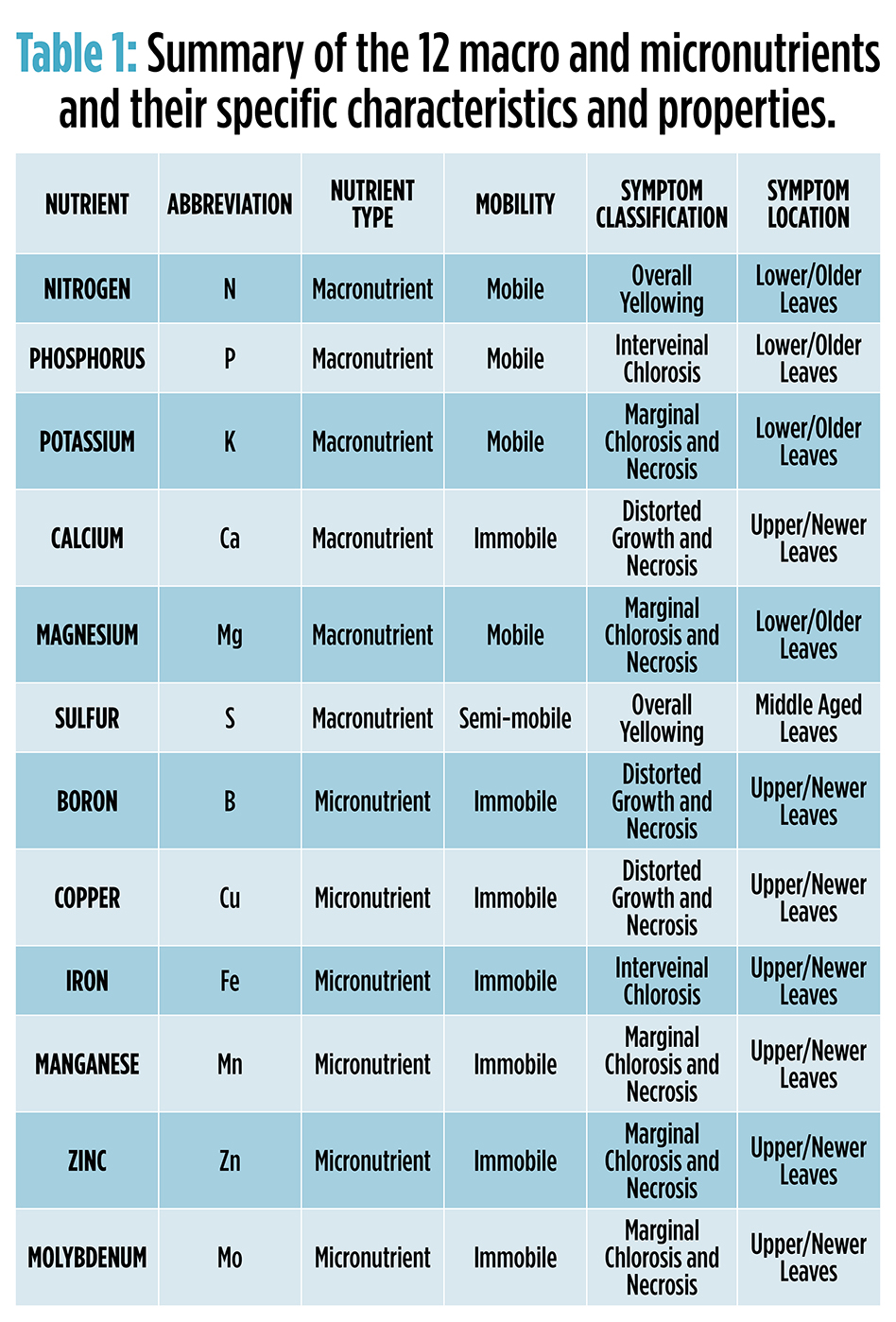
Paul Cockson
When troubleshooting nutrient disorders in cannabis, often the symptoms and possible culprits can be confusing. Additionally, the margins for success and failure can often be very small, making even incremental changes in cultural practices detrimental. Thus, learning the art and science of diagnostics is important and valuable.
Based on hemp research at North Carolina State University, researchers developed a diagnostic process that allows growers to cross reference physical symptoms and where they appear on the plant, focusing on six macronutrients and six micronutrients (see Table 1). It can help reduce the number of possibilities quite dramatically.
The first concept in our diagnostic process centers around the utilization of mineral nutrients in plants. Different nutrients will be utilized in certain physiological processes in the plant. For example, Ca, an immobile nutrient, develops deficiency symptoms of distorted or irregular new leaves in the new growth. This is because Ca is utilized in cell walls and is not able to be reallocated to new and developing cells. Thus, the older cells will have adequate Ca, while the newer cells will be Ca limited and have distorted cell wall formation translating into a distorted leaf and/or floral appearance. For mobile nutrients such as N or P, the deficiency symptoms will occur on the older or lower foliage due to reallocation of these resources to actively growing and developing leaves. Toxicities, on the other hand, often cause symptoms like leaf burn, spotting, or unusual coloration, such as dark green leaves in the case of excessive N. These visual symptoms are critical for diagnosing and addressing nutrient imbalances in plant cultivation.
The second concept in the diagnostic process centers around the mobility of mineral nutrients in plants. The concept of mobile and immobile nutrients in plants is crucial for understanding nutrient disorders. Mobile nutrients, such as N, P, and K, can be relocated within the plant to meet the demands of new growth. When these nutrients are deficient, symptoms first appear in older leaves as the plant redirects its limited supply to younger, more vital tissues. In contrast, immobile nutrients like Ca and Fe remain fixed in the place they are initially deposited, which is typically the cell walls. If these nutrients are lacking, deficiency symptoms manifest in the newer growths and leaves, as these parts cannot access the nutrients stored in older plant tissues. Understanding this distinction is vital for diagnosing nutrient deficiencies accurately and implementing appropriate corrective measures.
Thus, by cross-referencing the symptom appearances and the location of these symptoms in a plant, you can drastically improve diagnosis accuracy. It is important to note that visual diagnostics is only one tool; before making any changes, it is best to consult resources such as recently published scientific data and taking leaf tissue samples of the most recently mature leaves to help validate visual diagnostics.
Deficiency Symptoms by Appearance
Nutrient deficiencies and toxicities can loosely be categorized into four main groupings:
Group 1: Distorted growth and necrosis (Ca and B)
Group 2: Overall yellowing (N and S)
Group 3: Interveinal chlorosis (yellowing of tissue between veins) (P and Fe)
Group 4: Marginal chlorosis and necrosis (death) (K, Mg, Mn, Zn, and Mo)
It is important to note that there are certain nuances that exist within each of these broad categories. More exhaustive and detailed information has been published in scientific literature (Cockson et al., 2019). Additionally, Llewellyn et al, (2023) recently published visual deficiency symptoms during different growth stages. These broad categories are intended to narrow down the possible deficiencies you are observing.
Distortion and necrosis of the expanding leaves and growing tip (Group 1) are tell-tale signs of Ca and B deficiency. This is largely due to their role in cell wall stability and formation. When the new and developing leaves or flowers do not have enough of either of these elements, plant cell walls cannot adequately expand or reinforce. Often these leaves are described as distorted, hooded, tented, or shrunken (Figure 1).

Figure 1. This six-week old Cannabis sativa ‘T1’ plant received no B fertility. The leaflet margins are distorted and necrotic, and the leaf margins show curling and rolling. All photos by Paul Cockson
Overall yellowing (Group 2) and marginal yellowing with necrosis (Group 3) are the next two categories. The main difference is the exact cause of the yellowing. In the case of N deficiency, the chlorophyll is degraded because nitrogen (a mobile element) has moved to newer growth areas (Figure 2) and is indicative of overall yellowing symptomology. Interveinal chlorosis (Group 3), manifests in the tissue between the veins, which become yellow and later necrotic while the veins stay green (Figure 3).
 Figure 2. This composite photo shows the deficiency symptom progression of recently matured leaves from Cannabis sativa 'BaOx' plants lacking sufficient nitrogen (N).
Figure 2. This composite photo shows the deficiency symptom progression of recently matured leaves from Cannabis sativa 'BaOx' plants lacking sufficient nitrogen (N).
Signs of marginal chlorosis and necrosis (Group 4) include relatively uniformly distributed yellowing and necrosis occurring together. This is often indicative of K deficiency. It is important to note that depending on the stages of deficiencies (early vs. late) and also the developmental stages of the plant (vegetative, pre-flowering, or flowering) multiple deficiencies could be present. More details on the early vs. late symptomology and developmental stage specific symptom nuances can be found in the articles previously referenced. Given that many factors can influence the visual appearance of cannabis, it is important to cross reference by symptom location.
 Figure 3. This composite photo shows the deficiency symptom progression of recently matured leaves from a Cannabis sativa ‘BaOx’ plants with insufficient magnesium (Mg).
Figure 3. This composite photo shows the deficiency symptom progression of recently matured leaves from a Cannabis sativa ‘BaOx’ plants with insufficient magnesium (Mg).
Deficiency Symptoms by Mobility
The next level of diagnostics to investigate is the mobility of an element in the plant (Figure 4). As stated before, some elements are mobile while others are not largely due to how they are utilized in the plant. In plants, there are three main categories: mobile, semi-mobile, and immobile. Immobile elements will have symptoms appearing on the upper leaves or younger foliage. Mobile elements will have symptoms appearing on the lower leaves or older foliage. And semi mobile elements will often have symptoms in the middle of the plant or branch. When we combine the mobility of an element with its loose symptom categories discussed above, we can quickly narrow down the possibilities.

Figure 4. This composite photo shows the location of different nutrient deficiencies based on their mobility.
For example, say there is overall yellowing and necrosis on the leaves. This means we could potentially have a P or Fe deficiency. If these symptoms are on the older leaves or lower foliage, we can further narrow this down to a P deficiency. Again, growers are cautioned to utilize this method as a preliminary troubleshooting technique, which should be further verified through consulting production practice logs, testing fertilizer solutions, and taking a tissue sample before taking corrective action.
Table 1 (below) summarizes the information in this article and can be utilized as a resource. Growers are encouraged to utilize this process to begin their troubleshooting journey but should not rely on this process alone.

Latest from Cannabis Business Times
- Cannabis Industry Reacts to Biden’s Rescheduling Announcement
- As Predicted, 4/20 Sales Surged During Cannabis Industry Holiday Weekend
- DEA 2024 Report Focuses on THC Potency, Organized Crime, Youth Edible Consumption
- Nature's Miracle, Agrify Sign Definitive Merger Agreement
- 5 Things to Confirm When Signing a Cannabis Facility Construction Agreement
- Ziel Partners With Portocanna, Receives 1st EU GMP Certification for Microbial Control Technology in Cannabis
- White House Moves to Reschedule Cannabis in ‘Monumental’ Decision, Biden Says
- SOMAÍ Group, and Its Subsidiary, RPK Biopharma Expand Cookies Partnership to Include Europe and the UK





